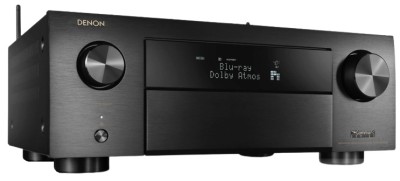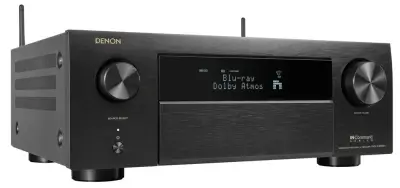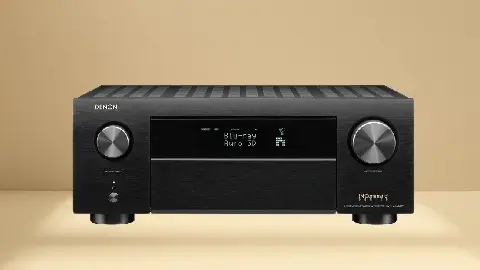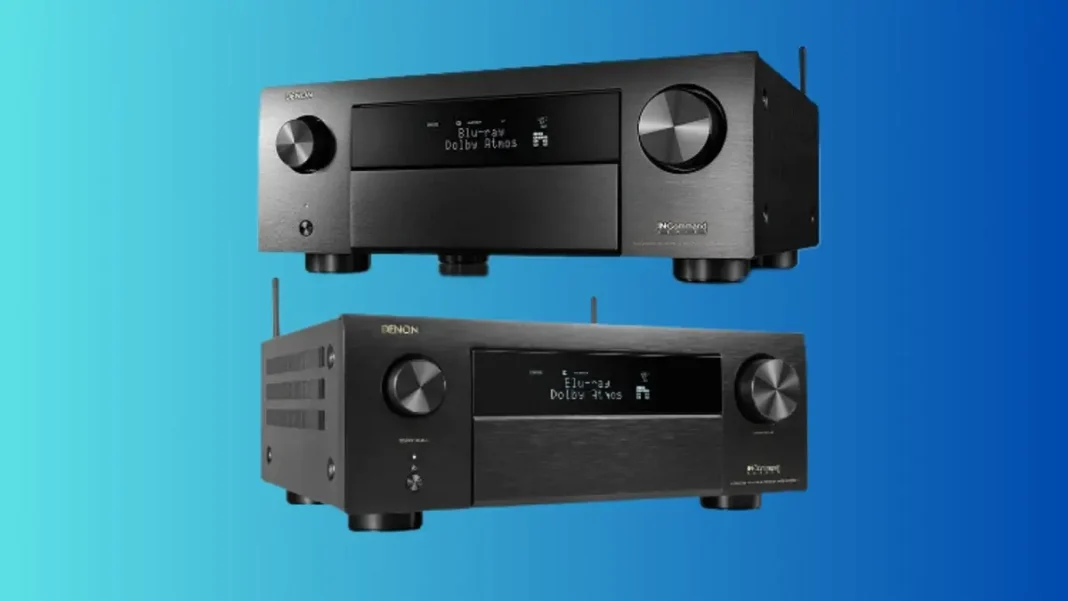Whether you are looking for your first AV receiver or replacing an existing one, you want to consider a few factors. Excellent audio and video quality are a couple of considerations, but it’s also nice when the receiver boasts a few features. Think of advanced technologies like built-in Wifi, 8K support, and multi-room streaming. It can take your entertainment system to new levels.
We are taking the time to compare two top-rated models, the Denon AVR-X4700H vs the AVR-X4800H to find out if these receivers meet consumer expectations. Find on Amazon
Denon AVR-X4700H vs AVR-X4800H Side-by-Side:
| Denon AVR-X4700H | Denon AVR-X4800H | |
|---|---|---|
 |  |
|
| Video | 8K/60Hz, 4K/120Hz | 8K/60Hz, 4K/120Hz |
| Amplifier | 9.2 Channel (125W per channel) | 9.4 channel (125W per channel) |
| Sound | 5.1.4 or 7.1.2 Dolby Atmos | Dolby Atmos, DTS:X Pro, IMAX Enhanced, and Auro 3D |
| Wi-Fi | Yes | Yes |
| Bluetooth | Yes | Yes |
| Price | Find on Amazon ProjectorScreen.com | Find on Amazon B&HPhotoVideo |
Audio Quality
Several factors determine audio quality. The onboard technology works to optimize sound performance while watts let you know how powerful the audio is in a room.
Both Denon AV receivers boast 125 watts per nine channels. It’s enough to fill a large room with high-quality audio. Dolby Atmos, DTS:X Pro, and Auro 3D give you immersive 3D audio.
The receivers even give you the illusion of surround sound without the need for ceiling speakers, thanks to Dolby Height Virtualization technology. Regardless of what you are listening to, you get clear and concise audio.
Best Audio Quality: A Tie
Video Quality
Video quality is just as crucial as audio. You want the onscreen picture to be as crisp and clear as the sound. It’s difficult to enjoy movies and shows when the images are fuzzy with little detail.
We are just as impressed with the video quality as the audio. Denon uses advanced technology to ensure images are bright and detailed with plenty of contrast. The receivers support the latest video formats including Dolby Vision, HLG, HDR, and HDR10+.
To prevent annoying video delays, the receivers support Quick Media Switching. The components are also 8K ready. It’s one of the factors we like about both models.
Best Video Quality: A Tie
Gaming Quality
Gamers can connect their consoles to either receiver and still get an impressive input lag and refresh rate. These are two factors every gamer pays attention to since each one affects the quality of their experience.
Using the 4K/120Hz pass-through, you can enjoy a smooth gaming experience. The same technology that produces stunning images also supports your games. Darker scenes are clear and colors rich and vivid.
We are disappointed to learn the X4700H does not support all media sources through the 4K/120Hz passthrough. It can limit the games you play.
We also like the Auto-low latency mode, along with Quick Frame Transport (QFT) and a variable refresh rate (VVR). While you may experience some delays on multi-player and graphic-rich games, the receivers are capable of keeping up with most action-packed ones.
Best Gaming Quality: Denon AVR-X4800H
Configuration
Most consumers prefer some flexibility with their speaker setup, especially when streaming audio to multiple rooms.
The AVR-X4800H offers a little more flexibility. Its 9.4 channels, compared to the 9.2 channels you get with the AVR-X4700H, allow you to configure your speakers for optimal sound quality.
Most Flexible Configuration: Denon AVR-X4800H
Ease of Installation and Set Up
Denon makes installation and setup easy for first-time users and experienced audio and videophiles.
Installing either AV receiver is a breeze. Denon’s award-winning onscreen assistant will walk you through the setup steps. Even calibrating your connecting speakers in multiple rooms only takes a few minutes. The Audyssey MultEQ technology calibrates the speakers and tunes the receiver for optimal sound quality. However, the X4800H is easier to calibrate. Along with MultEQ, it also has Dirac Live technology.
Easiest to Install and Setup: Denon AVR-X4800H
Connectivity
A robust connection panel on the receivers allows you to easily connect your devices. However, we are surprised to learn that the AVR-X4700H offers a little more connectivity wit.
You get eight HDMI inputs with the X4700H, compared to seven ports on the X4800H. The X4700H also comes with an additional composite and component output. Something else missing on the X4800H is radio support. However, the X4800H has more RCA and 8K inputs.
Best Connectivity: Denon AVR-X4700H
Additional Features
Consumers often expect their entertainment components to come with more than the basic features. It’s especially true when the price tag is slightly on the high side.
Along with onboard WiFi and Bluetooth, the receivers also have most of the popular streaming services including Spotify, Pandora, and more built-in. With onboard HEOS, you can stream audio around your home. The receivers are also compatible with Google and Alexa.
Best Additional Features: A Tie
Denon AVR-X4700H

Our tests show there’s a lot to like about the AVR-X4700H. Released in 2020, it has nine channels and 125 watts of power. Capable of processing 11.2 channels, you can easily add compatible speakers and extend your current configuration.
An extensive connection panel ensures you are not disconnecting devices to plug another component in. While there is only one 8K input, it’s currently enough for most entertainment systems.
We do appreciate the HDMI inputs, which include one on the front. The receiver also supports FM/AM radio via the analog tuner.
Pros
- Powerful sound
- 3D audio
- Low input lag
- Easy setup
- Flexible installation
Cons
- The 4K/120HZ passthrough does not support all types of content.
Denon AVR-X4800H

The AVR-X4800H, introduced in 2022, is advertised as an upgrade from the X4700H. It offers a more flexible speaker configuration with 9.4 channels. The addition of Dirac Live, also makes the receiver easier to set up.
It is lacking radio support, but it’s rarely an issue. The receiver supports most streaming services, including Tidal and Pandora. Anyone anxiously waiting for 8K resolution to become the new norm, is ready with seven 8K inputs. Click here for our more in-depth Denon AVR-X4800H review.
Pros
- Easy to calibrate across multiple rooms
- Crisp, clear audio
- Immersive images
- Multiple inputs
- 8K ready
Cons
- The receiver is not compatible with FM/AM radio stations.
Conclusion
We are not disappointed with either Denon receiver. Each has its strengths and weaknesses. The right model for you often depends on your entertainment needs and budget. You get a little more with the AVR-X4800H but the AVR-X4700H has a slightly lower price. (Check it on Amazon)
Related Comparisons:
- Denon AVR-X3800H vs AVR-X4700H: In-Depth Comparison
